Early Benefactions and Endowed Fellowships
Very few records were kept of the college’s financial transactions before Andrew Dokett died in 1484, after which the first account books were started. So we have few details of the earliest benefactions, unless they were for the purpose of founding (endowing) a Fellowship or Scholarship, in which case a record appears to have been kept in most cases.
Under the First Queen
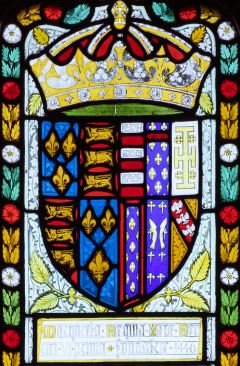
On 24 September 1459, William Lasby gave to the college a house on the corner of [the present] Queens’ Lane and Small Bridges Street [Silver Street]. [1867 pp.65–6]
Around 1461, Richard Andrewe bequeathed to the college 80 marks (£53.33) and properties in Cambridge and villages, to found a Bible-Clerk. [1867 p.66]
Richard Andrewe, alias Spycer, was a Burgess of Cambridge, and possibly a former Mayor. He had earlier been involved in the assembly of the site of the first foundation of St Bernard’s College. Some of this bequest, as descibed in his will, might have been subsequently swapped or traded, because by the time of an inventory of 1472, his benefaction was listed as four tenements in St Botolph’s parish and St Nicholas Hostel (one of the university hostels), between the present sites of Christ’s College and Emmanuel College. [1924 pp.89–91]
Under the Second Queen
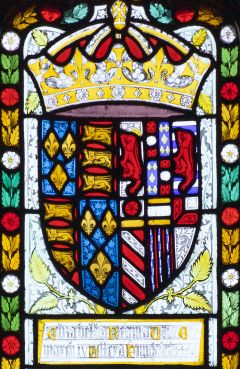 No record survives of any direct benefaction from Queen Elizabeth herself, although she is cited in the roll of benefactors, along with other members of the House of York, details of whose benefactions also do not survive.
No record survives of any direct benefaction from Queen Elizabeth herself, although she is cited in the roll of benefactors, along with other members of the House of York, details of whose benefactions also do not survive.
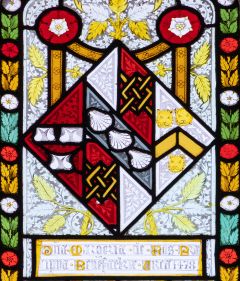 In 1469, Lady Margery Roos made a benefaction to found five Fellowships, proportionately the largest benefaction ever received by the college (apart from the short-lived benefaction of Queen Anne, below). Further benefactions followed in her will after she died in 1478. [1867 pp.72–5]
In 1469, Lady Margery Roos made a benefaction to found five Fellowships, proportionately the largest benefaction ever received by the college (apart from the short-lived benefaction of Queen Anne, below). Further benefactions followed in her will after she died in 1478. [1867 pp.72–5]
Margery (ca.1398–1478) was the daughter and sole heir of Philip le Despenser, 2nd Baron le Despenser, and Elizabeth (née de Tibetot, or Tiptoft). Margery was twice widowed. In ca.1404, as a child, she was married to John Ros, 7th Baron Ros of Helmsley (ca.1397–1421), who was killed in the Battle of Baugé: they had no children. Secondly, she married Roger Wentworth (ca.1395–1452), and had 6 children. In her will, she requested that her body be buried in the college chapel.[1867 pp.73–5] Histories of the college have assumed that such a burial actually took place, though we lack any surviving evidence of it. Other sources suggest that she was buried in the Grey Friars at Ipswich: however, Weever lists at Grey Friars her mother, father, and three siblings (who are assumed to have died without issue before their father), but not Margery.[1631 p.751] Notwithstanding erroneous statements in previous college histories, this benefactor was not the Lady Margaret Roos (ca.1425–1488) who was a lady-in-waiting to Queen Margaret of Anjou.[1985 p.182]
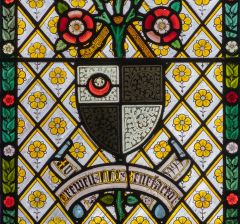 Around 1469, John Druell (or Drewell) made benefactions to found two Fellowships and a Scholarship. [1867 p.122]
Around 1469, John Druell (or Drewell) made benefactions to found two Fellowships and a Scholarship. [1867 p.122]
John Druell (or Drewell, Drowell, Druel, Drwell) (d.1469) was Canon and Prebendary of Oxgate, and Treasurer, at St Paul’s London (resigned 1467). Possibly a Fellow of Queens’. His executor was Willliam Wylde, who was Druell’s successor at St Paul’s, and was in correspondence with the college concerning Druell’s exequies as late as 1495: this seems to have resulted in Druell’s benefaction being misdated in college histories. Wylde was also a smaller benefactor.
Not to be confused with the John Druell (d.1453) who was Archdeacon of Exeter.
In 1470, William Syday (or Sydaie, Sida), “Doctor of Physick in this University”, founded a Fellowship. [1867 p.77]
William Syday (d.1468) bequeathed the land and tenement known as “Bilney’s Hostel”, later called “St Paul’s Inn”, one of the university hostels. It stood on Market Street, where Rose Crescent now joins. [1924 pp.65, 92]
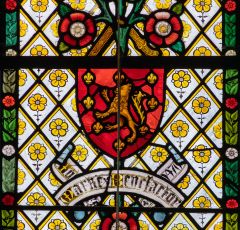 Around 1471, John Marke, haberdasher and citizen of London, gave land and property in Bermondsey, including the “Christopher Inn”, with which to found a Fellowship after his death. This Fellowship was first filled in 1490.[1867 p.79]
Around 1471, John Marke, haberdasher and citizen of London, gave land and property in Bermondsey, including the “Christopher Inn”, with which to found a Fellowship after his death. This Fellowship was first filled in 1490.[1867 p.79]
John Marke had been an executor to the will of Henry Somer (d.1450). This will included Also I will and arrange that immediately after my decease the aforesaid John Marke shall have and enjoy during his whole life all my lands and tenements in Bermondsey street in the county of Surrey, and after the decease of the said John Marke I will that they be sold by my executors.
Another document suggests that Andrew Dokett had been involved with this property as early as 1461.
John Barby made a benefaction to found a Fellowship.
John Barby (or Berby) (d. by 1468) was a Mercer of London. The date of his benefaction is not clear. In the 1823 Commemoration of Benefactors, the founding date is given as 1495 [1823 p.5], but this is probably a misreading of Plumptre’s history [1788 f.90r], where the wording is clear that 1495 was the date that money from this benefaction was used to purchase property in Bermondsey Street, not the date of the benefaction itself. In Searle’s history, the benefaction is not recorded, but the named Fellowship is recorded as already existing by 1484, when the account books started. [1867 p.119] The income from this benefaction was found insufficient to fully fund a Fellowship, and this benefaction was combined with part of that of Otwar from 1486 onwards. The name of John Barby is seen in some legal documents alongside that of Hugh Wyche (benefactor, see below), for instance the Foot of Fine at CP 25/1/294/74, number 24, November 1464. The properties described there are the same as those later purchased by the college from George Dawne in 1469 with the benefaction of Margery Roos (see above). [Cal.Cl.R. Edw IV v.2, No.471]
John Otwar made a benefaction to found a Fellowship.
John Otwar (or Ottwar, Otware, Otteware) was appointed Rector of Aldham, Essex in 1497. The date of his benefaction is not clear. In the 1823 Commemoration of Benefactors, the founding date is given as 1471. [1823 p.4] In Searle’s history, the benefaction is not recorded, but the named Fellowship is recorded as first seen in the account books in 1485. [1867 p.119] Part of this benefaction was combined with that of Barby from 1486 onwards. [1867 p.119] In 1505, money from the Otwar benefaction was used to purchase land at Babraham. [1823 p.4]
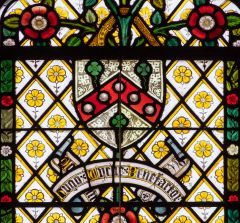 Around 1472, Dame Alice Wyche founded a Fellowship, by a gift of £320 used to purchase lands with an annual yield of £12.[1867 pp.80–1]
Around 1472, Dame Alice Wyche founded a Fellowship, by a gift of £320 used to purchase lands with an annual yield of £12.[1867 pp.80–1]
Alice (d.1474) was a daughter of John Walters Stratton and Elizabeth née Luttrell. Alice was twice widowed. She was married first to William Holt (d.1464), Mercer, and secondly as the third wife of Sir Hugh Wyche (or Wych, Wiche, Wich) (d.1468). Both men had been wealthy merchants in the wool trade. Hugh was a Mercer, Sheriff of London 1444–5, M.P. 1447, Alderman 1458 onwards, Mayor 1461–2. Hugh was one of three aldermen who loaned money to the young King Edward IV, and who were rewarded by being created Knights of the Bath in 1465 during the celebrations for the coronation of Elizabeth Woodville.[1923 p.376] Hugh died childless. There is no mention of children in Alice’s will.
According to the roll of benefactors, Hugh Wyche had been an earlier benefactor, as well.
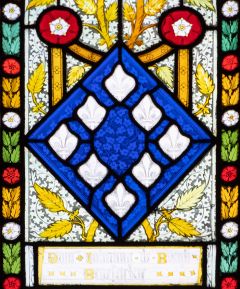 On 1473 March 5, the king granted a licence allowing Lady Joan Burgh to donate the estate of St Nicholas Court in the Isle of Thanet to the college in order to found a fellowship after her death [Cal.Pat.R. 13 Edw IV Pt 1, m.10, p.394] [1867 pp.81–3].
On 1473 March 5, the king granted a licence allowing Lady Joan Burgh to donate the estate of St Nicholas Court in the Isle of Thanet to the college in order to found a fellowship after her death [Cal.Pat.R. 13 Edw IV Pt 1, m.10, p.394] [1867 pp.81–3].
The estate was re-granted to her for her lifetime, and returned to the college after her death in ca.1493.
Jane (as she was named in contemporary documents) was the widow of Sir John Burgh (or Bourgh, Borough) of Wattlesborough and Cause (1414–71), and Lord of Mawddwy, Sheriff of Shropshire, M.P. for Shropshire.
John Burgh married Jane née Clopton. One source states that Jane pre-deceased John, and that he secondly married another Jane, who became his widow [1862 pp.225,231], but that statement does not appear in the same author’s later account [1876 pp.275,289].
Jane, widow of Sir John Burgh, is also referred to as widow of William Porte (or Poorte) in chancery records.
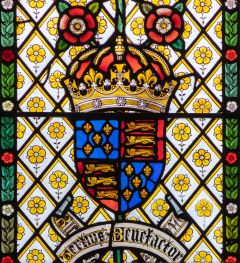 On 1 April 1477, Richard, Duke of Gloucester, via his feoffees, with the agreement of the King,[Cal.Pat.R. 17 Edw IV Pt 1, m.17 p.34, 1477 April 10] gave the Manor of Fowlmere to the college, to be used in accordance with a later indenture. [1867 pp.87–8]
On 1 April 1477, Richard, Duke of Gloucester, via his feoffees, with the agreement of the King,[Cal.Pat.R. 17 Edw IV Pt 1, m.17 p.34, 1477 April 10] gave the Manor of Fowlmere to the college, to be used in accordance with a later indenture. [1867 pp.87–8]
In 1462, John de Vere, 12th Earl of Oxford, a Lancastrian supporter, had been executed for treason, and his estates, and those of his wife Elizabeth, forfeited to the King, Edward IV. The King granted those forfeited estates to his brother Richard, Duke of Gloucester. One of the estates inherited by Elizabeth, Countess of Oxford, had been the Manor of Fowlmere.
On 17 July 1477 Richard Duke of Gloucester made an indenture (in English) stipulating that the income from the Manor of Fowlmere was to found four new Fellowships. These fellowships were to be known as The Four Priests of the Duke of Gloucester’s Foundation
. [1867 pp.89–92]
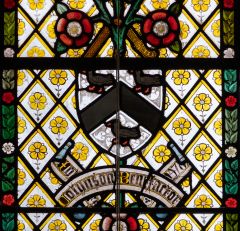 In 1478, John Collinson (or Colynson) (d.1482), Prebendary (Louth) of Lincoln (1455–), Archdeacon of Stow (1460–68), of Bedford (1468–71), of Northampton (1471–), Rector of Over (1472–), founded a fellowship. [1867 p.93]
In 1478, John Collinson (or Colynson) (d.1482), Prebendary (Louth) of Lincoln (1455–), Archdeacon of Stow (1460–68), of Bedford (1468–71), of Northampton (1471–), Rector of Over (1472–), founded a fellowship. [1867 p.93]
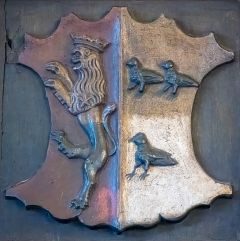 In 1479, John Grene founded a fellowship, through his executors (his widow Edith and his brother). [1867 pp.93–4]
In 1479, John Grene founded a fellowship, through his executors (his widow Edith and his brother). [1867 pp.93–4]
John Grene (or Green, Greene) (d.1473), of Gosfield, Essex, was the son of John Grene of Widdington in Essex and Agnes née Duke. In ca.1450/1, John (the benefactor) married, as second husband, Edith née Rolfe (ca.1415–98), widow of John Helion (or Helyon) (d.1449).Lawyer, J.P. M.P. for Essex 1455, 1460. Speaker of the House of Commons 1460.
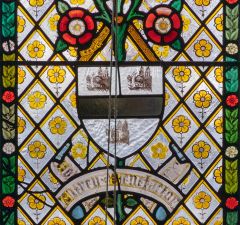 In 1481, John Alfray (or Alfrey) made a benefaction of lands with which to found a Fellowship after his death. [1867 p.94]
In 1481, John Alfray (or Alfrey) made a benefaction of lands with which to found a Fellowship after his death. [1867 p.94]
John Alfray had also been a witness signatory to the will of Margery Roos in 1478. This benefactor, described as “gentleman of Ipswich”, might be this John Alfray (a Burgess of Ipswich in 1469), or his son. A John Alfray was elected to be a Burgess of Ipswich in 1481 and Treasurer of Ipswich in 1482.
In 1481, the executors of Sir John Skrene (d. 1474) made a benefaction of lands with which to found a chantry for his soul. [2011]
Under the Third Queen
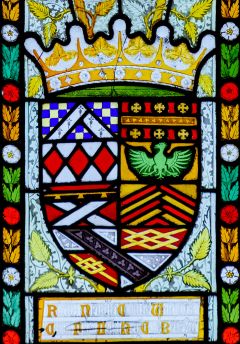 On 5 July 1484, King Richard III, by letters patent,[Cal.Pat.R. 2 Ric III Pt 1, m.12, p.477] made a large benefaction to the college, consisting of many estates owned by Queen Anne, plus £110 per year from the income of other estates. [1867 pp.97–100]
On 5 July 1484, King Richard III, by letters patent,[Cal.Pat.R. 2 Ric III Pt 1, m.12, p.477] made a large benefaction to the college, consisting of many estates owned by Queen Anne, plus £110 per year from the income of other estates. [1867 pp.97–100]
By extrapolation from the first half-year accounts of the income actually received, the annual value of this benefaction was £265 15s 8d. [1867 p.111] This single benefaction more than doubled the annual income of the college. The fellows appointed from this benefaction were referred to as Fellows of Queen Anne’s Foundation
. Records suggest that there might have been as many as 33 such Fellows on Queen Anne’s Foundation at one point. [1867 p.112]
Andrew Dokett, the first President of Queens’ College, died in November 1484. Queen Anne died 16 March 1485. King Richard III was killed in battle 22 August 1485.
The new King Henry VII reverted all Richard’s and Anne’s gifts, both 1477 and 1484. So the annual income of the college returned to being less than £200 per year.
Later endowed Fellowships
The following Fellowship endowments, although arriving after the death of Andrew Dokett, belong to the sequence of benefactions made from 1469 onwards, and might have been organised during his lifetime.
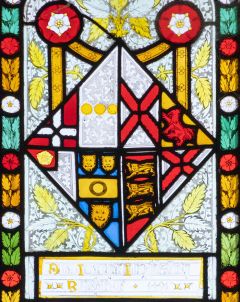 In 1491, Lady Joan Ingaldesthorpe made a benefaction to found a Fellowship. [1867 pp.119–20]
In 1491, Lady Joan Ingaldesthorpe made a benefaction to found a Fellowship. [1867 pp.119–20]
Joanna (or Joan) (ca.1425–1494) was the daughter of John Tiptoft (1383–1443) and his second wife Joyce née Charlton (1403–1446). Joan was twice widowed. Her husbands were, first, Sir Edmund Ingaldesthorpe (ca.1421–1456), then Thomas Grey (1418–61). (Thomas was a half-uncle to Sir John Grey of Groby, the first husband of Elizabeth Woodville).
Through her father, Joan was a half-2nd-cousin of Lady Margery Roos (benefactrix), as they shared a great-grandfather John Tiptoft (1313–67), but through different wives.
Through her mother, Joan was a 3rd cousin of Jane Burgh née Clopton (benefactrix), as they shared a great-great-grandfather Sir John de Cherleton, 2nd Lord Cherleton (d.1360).
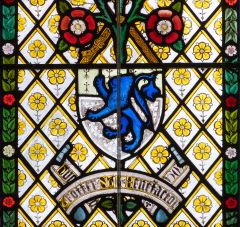 In 1502, Hugh Trotter made a benefaction of £253 6s 8d with the intention of founding a Fellowship. The candidate that he had in mind to appoint to his Fellowship was excluded from a true lifetime Foundation Fellowship by the 1475 statutes, as he came from the same county as an existing Fellow. So the candidate was admitted as a member of the college “during Mr Trotter’s pleasure”. The Trotter Fellow was eventually incorporated into the Foundation in 1549. [1867 p.124]
In 1502, Hugh Trotter made a benefaction of £253 6s 8d with the intention of founding a Fellowship. The candidate that he had in mind to appoint to his Fellowship was excluded from a true lifetime Foundation Fellowship by the 1475 statutes, as he came from the same county as an existing Fellow. So the candidate was admitted as a member of the college “during Mr Trotter’s pleasure”. The Trotter Fellow was eventually incorporated into the Foundation in 1549. [1867 p.124]
Hugh Trotter (or Troter, Trottar) (d. 1503) had been a student of the college, graduating B.A. 1469/70, M.A. 1473/4. Fellow no later than 1484 until 1489. B.D. 1481/2, D.D. 1488. Senior Bursar 1484–85, Junior Bursar 1485–87, Senior Bursar 1487–88. Rector of Wilford, Notts 1489–94. Canon of York & Prebendary of Dunnington 1491 Jan–Dec. Canon of Southwell & Prebendary of Palishall 1491–3. Provost of Beverley 1493–. Prebendary of St Michael’s altar in Beverley Minster 1493–. Precentor of York and Prebendary of Driffield 1494 Jan–Jun. Treasurer of York 1494–. [1963 pp.595–6]
Postscripts
After the Trotter benefaction, there were no further Fellowships endowed until the 21st century.
After the loss of the Fellowships endowed by King Richard III and Queen Anne, the number of endowed Fellowships was 18:
Priests: Roos (5), Drewell (2), Burgh, Wyche, Marke, Alfrey, Ingaldesthorpe, Syday, Greene, Collinson, Trotter;
Non-priests: Barby (Law), Otwar (Medicine).
This established the maximum size of the Fellowship as 18 until well into the 20th century (when lower-cost Fellowships became possible for academics with university teaching posts), but for much of the time there were many fewer Fellows in office, sinking as low as 8 towards the end of the 19th century.
References and Further Reading
1572: Catalogus Cancellariorum, Procancellariorum, Procuratorum, ac eorum qui in Achademia Cantabrigiensi ad gradum Doctoratus aspiraverunt, by Archbishop Matthew Parker, pp. 41–2;
1729: Edition as Academiae Historia Cantebrigiensis appended to De Antiquitate Britannicae Ecclesiae …, by Samuel Drake, p. xx.
1574: Historiæ Cantebrigiensis Academiæ ab urbe condita, by John Caius, Liber primus, pp. 70–1; (OCLC 60367592)
1912: Edition within The Works of John Caius, M.D. by Ernest Stewart Roberts, pp. 56–7. (OCLC 11548071)
1622a: Σκελετός Cantabrigiensis, by Richard Parker (unpublished manuscript);
1715: Edition in Latin appended to Leland’s Collecteana, Volume V, edited by Thomas Hearne, pp. 225–8;
1721: Edition in English, in The History and Antiquities of the University of Cambridge, pub. by Thomas Warner, pp. 109–13; [plagiarised by Carter 1753]
1774: Second edition of 1715 Latin version, pp. 225–8.
1622b: The Foundation of the Universitie of Cambridge, by John Scot the Elder; (OCLC 33143124) [tabular form; significant error in account of Queens’]
1634: Another edition, (OCLC 607140137); [corrected, esp. in relation to Queens’, and updated]
1651: Another edition, attrib. Gerard Langbaine, pp. 9–10; (OCLC 265490979) [text from 1634 edition in book form]
1672: Another edition, by John Ivory. (OCLC 49268897) [reverting to tabular form]
1631: Ancient funerall monuments …, by John Weever. (OCLC 84623819)
1655: The History of the University of Cambridge, by Thomas Fuller, Section V, ¶¶31–39, pp. 79–82; (OCLC 752917426)
1655: often bound with The church-history of Britain; (OCLC 13589226)
1840: Edition by James Nichols, pp. 120–3; (OCLC 6928511)
1840: Edition by Marmaduke Prickett and Thomas Wright, pp. 161–6. (OCLC 1977548)
1721: The History and Antiquities of the University of Cambridge : in two parts, pub. by Thomas Warner, pp. 109–13.
[the first part is a translation into English of the fictional Historiola by Nicholas Cantelupe of the foundation of the university; the second part is a translation into English of the 1622 Σκελετός Cantabrigiensis, by Richard Parker: subsequently plagiarised by Carter 1753]
1726: Collectanea Anglo-Minoritica: The Antiquities of the English Franciscans, by Anthony Parkinson, pp. 205–6. (OCLC 6055232) [questions Richard Parker's 1622 account of Andrew Dokett]
1753: The History of the University of Cambridge, from its Original, to the year 1753, by Edmund Carter, pp. 175–96. [plagiarised from the 1721 English edition of Richard Parker’s Σκελετός Cantabrigiensis of 1622]
1788: The History of Queens College in Cambridge, by Robert Plumptre [President 1760–88], QC Library MS101.
1823: A Form for the Commemoration of Benefactors, to be used in the Chapel of the College of St Margaret and St Bernard, commonly called Queens’ College, Cambridge, edited by George Cornelius Gorham. [Serves as a catalogue of benefactions. Two copies bound together, the first interleaved, with MS. notes by the editor & W.G. Searle, the second with notes by Searle only, in University Library as Adv.b.94.2 (OCLC 55863359)] (OCLC 55861566)
1862: The Princes of Upper Powys, by George Thomas Orlando Bridgeman, in Collectanea Archæologica: Communications made to the British Archaeological Association, Vol. 1, pp. 79–89, 182–231. (OCLC 8769369) [Sir John Burgh at pp.223 onwards, and 231]
1867: The History of the Queens’ College of St Margaret and St Bernard in the University of Cambridge, by William George Searle, Volume 1, 1446–1560, Cambridge Antiquarian Society Octavo Publications No IX;
1871: Volume 2, 1560–1662, Cambridge Antiquarian Society Octavo Publications No XIII. (Both vols OCLC 3279381)
[In QC Old Library there are (a) a manuscript index for the two published volumes, (b) interleaved editions of the two published volumes with manuscript corrections and updates, (c) preparatory manuscript materials for further volumes].
1876: History of the Princes of South Wales, by George Thomas Orlando Bridgeman. (OCLC 4608036) [Sir John Burgh at pp.275 & 289]
1886: The Architectural History of the University of Cambridge, by Robert Willis and John Willis Clark, Volume 1; (OCLC 6104300)
1886: Volume 2 (incl. Queens’ pp. 1–68 and 770–1);
1886: Volume 3 with Index;
1886: Volume 4 plans.
1898: The Queen’s College of S. Margaret and S. Bernard (1448–1898), by John Willis Clark (OCLC 55865473) [for 450th anniversary]
1899: The Queens’ College of St Margaret and St Bernard in the University of Cambridge, by Joseph Henry Gray; (OCLC 8568413)
1926: New edition, updated. (OCLC 79562186)
1907: The Cambridge Colleges—VIII: The History of Queens’, by Joseph Henry Gray, in The Crown, the Court and County Families Newspaper, 1907 Nov 2nd, pp. 219–20. (OCLC 54335090)
1910: Queens’ College, Cambridge, by C. W.
in Country Life, Vol. XXVII, No. 684, 1910 February 12, pp. 239–43. (ISSN 0045-8856)
1922: A little history of S. Botolph’s, Cambridge, by Arthur Worthington Goodman. (OCLC 776794335)
1923: The Life and Reign of Edward the Fourth, by Cora Louise Scofield (1870–1962). (OCLC 266083121)
1924: The Mediæval Hostels of the University of Cambridge, by Henry Paine Stokes; (OCLC 13647604)
1931: Queens’ College Cambridge, by Arthur Stanley Oswald, Part 1, in Country Life, Vol. LXIX, No. 1779, February 21, pp. 222–8; (ISSN 0045-8856)
1931: Part 2, in Vol. LXIX, No. 1780, February 28, pp. 262–8;
1931: Part 3, in Vol. LXIX, No. 1781, March 7, pp. 290–6.
1936: A history of St. Catharine’s College, once Catharine Hall, Cambridge, by William Henry Samuel Jones. (OCLC 5023706) [Chapter 1 relevant to the site of the first foundation of St Bernard’s College]
1951: A Pictorial History of the Queen’s College of Saint Margaret and Saint Bernard, commonly called Queens’ College Cambridge, 1448–1948, by Archibald Douglas Browne (1889–1977) & Charles Theodore Seltman. (OCLC 7790464)
1963: A Biographical Register of the University of Cambridge to 1500, by Alfred Brotherston Emden. (OCLC 709975)
1966: Cambridge University Press 1696–1712: A Bibliographical Study, by Donald Francis McKenzie. (OCLC 11174583) [Chapter 2 relevant to the site of the first foundation of St Bernard’s College, subject to corrections in 1991]
1985: The Household of Queen Margaret of Anjou 1452–3, by Alexander Reginald Myers (1912–1980), in Crown, Household, and Parliament in Fifteenth Century England, pp. 135–209. (ISBN 978-0-907628-63-7)
1987: A History of Queens’ College, Cambridge, 1448–1986, by John Twigg. (ISBN 978-0-85115-488-6)
1991: A Cambridge Playhouse of 1638?: Reconsiderations, by Alan H. Nelson; and Iain Richard Wright [Fellow], in Renaissance Drama, New Series vol. 22, pp. 175–89. (ISSN 0486-3739 eISSN 2164-3415) [response to the 1966 book and 1970 article A Cambridge Playhouse of 1638?]
2011: Sir John Skrene, Richard of Gloucester and Queens’ College, Cambridge, by Anne Frances Sutton, in The Ricardian, Vol. XXI, pp. 23–46. (ISSN 0048-8267)
2022: Queens’ College, Cambridge, by John Goodall, photos by Will Pryce, in Country Life, Vol. CCXVIII, 2022: Part 1 in No. 5, February 2, pp. 62–67; Part 2 in No. 6, February 9, pp. 46–51. (ISSN 0045-8856)
2022: The First 40 Presidents of Queens’ College Cambridge : Their Lives and Times, by Jonathan Hudson Dowson [Fellow Commoner]. (ISBN 978-1-83975-889-8)